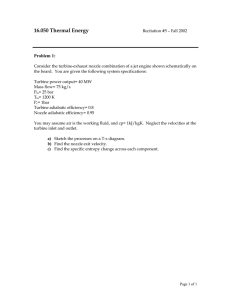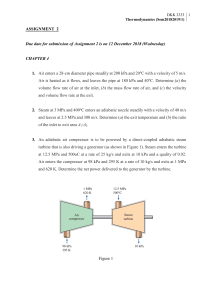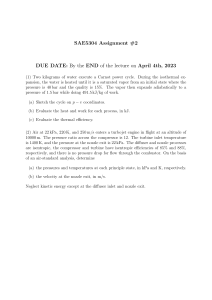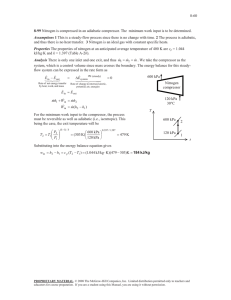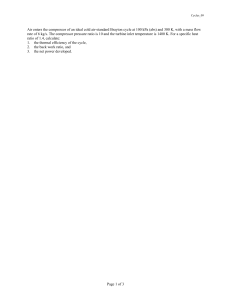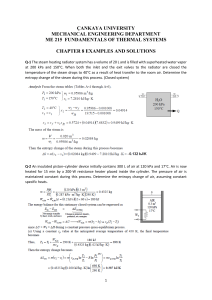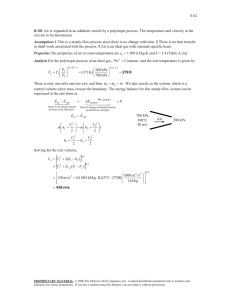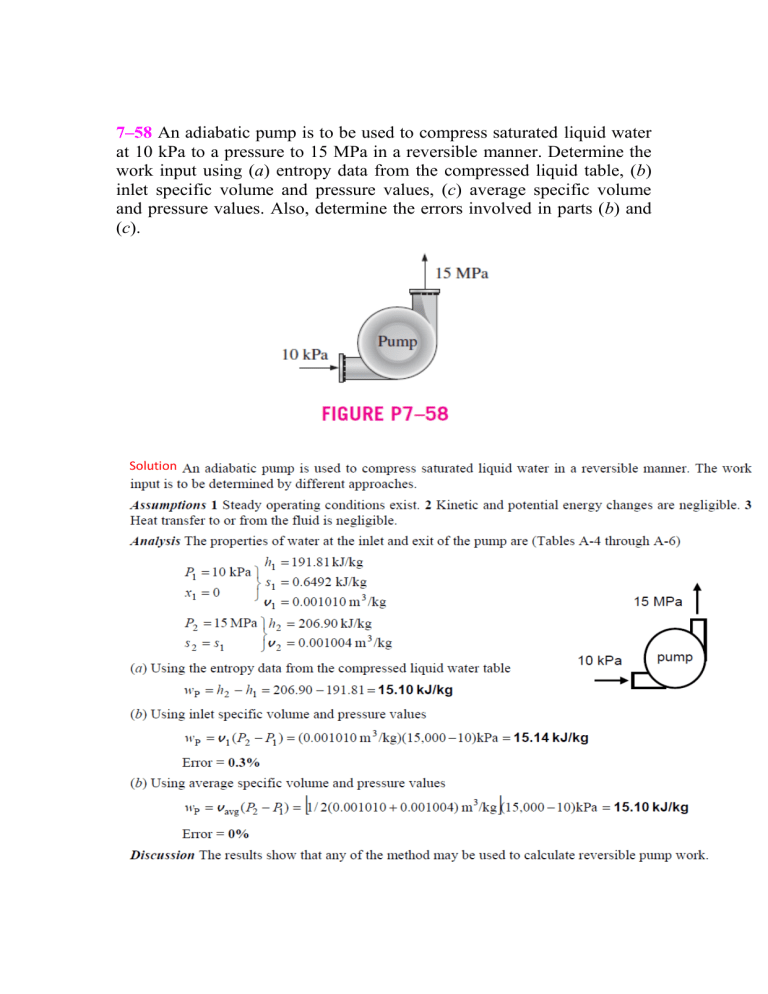
7–58 An adiabatic pump is to be used to compress saturated liquid water at 10 kPa to a pressure to 15 MPa in a reversible manner. Determine the work input using (a) entropy data from the compressed liquid table, (b) inlet specific volume and pressure values, (c) average specific volume and pressure values. Also, determine the errors involved in parts (b) and (c). Solution 7–90 Water enters the pump of a steam power plant as saturated liquid at 20 kPa at a rate of 45 kg/s and exits at 6 MPa. Neglecting the changes in kinetic and potential energies and assuming the process to be reversible, determine the power input to the pump. Solution 7–91 Liquid water enters a 25-kW pump at 100-kPa pressure at a rate of 5 kg/s. Determine the highest pressure the liquid water can have at the exit of the pump. Neglect the kinetic and potential energy changes of water, and take the specific volume of water to be 0.001 m3/kg. Answer: 5100 kPa Solution 7–93 Consider a steam power plant that operates between the pressure limits of 10 MPa and 20 kPa. Steam enters the pump as saturated liquid and leaves the turbine as saturated vapor. Determine the ratio of the work delivered by the turbine to the work consumed by the pump. Assume the entire cycle to be reversible and the heat losses from the pump and the turbine to be negligible. Solution 7–95 Liquid water at 120 kPa enters a 7-kW pump where its pressure is raised to 5 MPa. If the elevation difference between the exit and the inlet levels is 10 m, determine the highest mass flow rate of liquid water this pump can handle. Neglect the kinetic energy change of water, and take the specific volume of water to be 0.001 m3/kg. Solution Liquid water is pumped by a 7-kW pump to a specified pressure at a specified level. The highest possible mass flow rate of water is to be determined 7–96 Helium gas is compressed from 100 kPa and 20°C to 850 kPa at a rate of 0.15 m3/s. Determine the power input to the compressor, assuming the compression process to be (a) isentropic, (b) polytropic with n = 1.2, (c) isothermal, and (d) ideal two-stage polytropic with n = 1.2. Solution 7–98 Nitrogen gas is compressed from 80 kPa and 27°C to 480 kPa by a 10-kW compressor. Determine the mass flow rate of nitrogen through the compressor, assuming the compression process to be (a) isentropic, (b) polytropic with n = 1.3, (c) isothermal, and (d) ideal two-stage polytropic with n = 1.3. Answers: (a) 0.048 kg/s, (b) 0.051 kg/s, (c) 0.063 kg/s, (d) 0.056 kg/s Solution 7–101C Describe the ideal process for an (a) adiabatic turbine, (b) adiabatic compressor, and (c) adiabatic nozzle, and define the isentropic efficiency for each device. Solution The ideal process for all three devices is the reversible adiabatic (i.e., isentropic) process. The adiabatic efficiencies of these devices are defined as 7–104 Steam enters an adiabatic turbine at 8 MPa and 500°C with a mass flow rate of 3 kg/s and leaves at 30 kPa. The isentropic efficiency of the turbine is 0.90. Neglecting the kinetic energy change of the steam, determine (a) the temperature at the turbine exit and (b) the power output of the turbine. Answers: (a) 69.1°C, (b) 3054 kW Solution 7–106 Steam enters an adiabatic turbine at 7 MPa, 600°C, and 80 m/s and leaves at 50 kPa, 150°C, and 140 m/s. If the power output of the turbine is 6 MW, determine (a) the mass flow rate of the steam flowing through the turbine and (b) the isentropic efficiency of the turbine. Answers: (a) 6.95 kg/s, (b) 73.4 percent Solution 7–107 Argon gas enters an adiabatic turbine at 800°C and 1.5 MPa at a rate of 80 kg/min and exhausts at 200 kPa. If the power output of the turbine is 370 kW, determine the isentropic efficiency of the turbine. Solution 7–109 Refrigerant-134a enters an adiabatic compressor as saturated vapor at 120 kPa at a rate of 0.3 m3/min and exits at 1-MPa pressure. If the isentropic efficiency of the compressor is 80 percent, determine (a) the temperature of the refrigerant at the exit of the compressor and (b) the power input, in kW. Also, show the process on a T-s diagram with respect to saturation lines. Solution 7–111 Air enters an adiabatic compressor at 100 kPa and 17°C at a rate of 2.4 m3/s, and it exits at 257°C. The compressor has an isentropic efficiency of 84 percent. Neglecting the changes in kinetic and potential energies, determine (a) the exit pressure of air and (b) the power required to drive the compressor. Solution 7–112 Air is compressed by an adiabatic compressor from 95 kPa and 27°C to 600 kPa and 277°C. Assuming variable specific heats and neglecting the changes in kinetic and potential energies, determine (a) the isentropic efficiency of the compressor and (b) the exit temperature of air if the process were reversible. Answers: (a) 81.9 percent, (b) 505.5 K Solution 7–113 Argon gas enters an adiabatic compressor at 150 kPa and 30°C with a velocity of 20 m/s, and it exits at 1400 kPa and 75 m/s. If the isentropic efficiency of the compressor is 80 percent, determine (a) the exit temperature of the argon and (b) the work input to the compressor. Solution 7–114 Carbon dioxide enters an adiabatic compressor at 100 kPa and 300 K at a rate of 1.8 kg/s and exits at 600 kPa and 450 K. Neglecting the kinetic energy changes, determine the isentropic efficiency of the compressor. Solution 7–115 Air enters an adiabatic nozzle at 400 kPa and 547°C with low velocity and exits at 240 m/s. If the isentropic efficiency of the nozzle is 90 percent, determine the exit temperature and pressure of the air. Solution 7–117 Hot combustion gases enter the nozzle of a turbojet engine at 260 kPa, 747°C, and 80 m/s, and they exit at a pressure of 85 kPa. Assuming an isentropic efficiency of 92 percent and treating the combustion gases as air, determine (a) the exit velocity and (b) the exit temperature. Answers: (a) 728.2 m/s, (b) 786.3 K Solution
